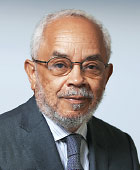There has been much talk about “The Harlem Renaissance and Transatlantic Modernism,” a current exhibit at the Metropolitan Museum of Art (The Met) on New York City’s Fifth Avenue. With the breadth and intensity of the advertising, I had to witness this event directly. The show was clearly a landmark happening on the broad cultural scene as well as in the world of American art.
Regardless of the debates in this country about race matters, the exhibit’s visitors on the day I attended were diverse in all sorts of ways. Grandmothers explained images to their grandchildren. White, Black, and Brown people exchanged friendly glances and patiently waited in turn to examine a piece of art. I finally gave up counting the different languages being spoken around me. Dignity was in the air, and self-satisfaction was engraved on many faces. The entire scene illustrated the notion of curiosity about the other, something that psychiatrists usually find so hard to explain.
Allison Meier, writing in The Art Newspaper (February 20) pointed out that in 1969, at the same museum, the exhibit “Harlem on My Mind” opened without including any Black painters or sculptors. Critics noted that talking about Harlem, while disregarding “the pivotal role of artists in the activism and community of Harlem,” made little sense. It represented an insidious form of segregation. Holland Cotter, in “The Met Aims to Get Harlem Right, the Second Time Around” (The New York Times, February 19), mentioned that there was apparently considerable picketing around the Met at the time by a group of contemporary artists who demanded inclusion and affirmation of their cultural identity, “in art as in life.” Cotter noted that while The Met did not frame the current exhibit as an “institutional correction,” one could characterize it as “moving a still-neglected art history out of the wings and onto the main stage.” In 1987, things were better at the Studio Museum of Harlem’s show called “Harlem Renaissance: Art of Black America,” curated by Mary Campbell and David Driskell. The catalogue (Harlem Renaissance: Art of Black America, 1987), which accompanied that exhibit, offers a helpful summary of the Harlem Renaissance movement.
Cotter referred to the Harlem Renaissance as running roughly from 1918 through the 1930s. There is fluidity about this conceptualization, as artists working outside that period are mentioned in relation to the movement. Not all of them lived in Harlem, and neither was the movement considered only a visual art phenomenon. Writers and musicians were included, as well as photographers. That was when, as the curators noted, artists were engaging with Black writers, performers, and composers in what was also called the New Negro movement. Veronica Chambers and Michelle May-Curry (“The Dinner Party That Started the Harlem Renaissance,” The New York Times, March 21) suggested that the Harlem Renaissance represented “a flowering of intellectual and artistic activity that would give the neighborhood and its residents global renown.” Three intellectual stalwarts of the time, Alain Locke, W.E.B. Du Bois, and Charles Johnson are often named as leaders of the movement.
Allison Meier pointed out that Alain Locke, as the theorist of the Harlem Renaissance, adopted a point of view or ethos concerning the work of Black American artists. Locke wanted them to respect the artistic heritage of Africa, particularly its sculptural tradition. The result, he hoped, would be an authentic African American aesthetic. This intellectualized approach found support among painters and sculptors who were familiar with the European scene. Other Black American artists turned to glorifying the tradition of Black folklore and creating a kind of primitive art form. There were still others who focused on the details of Black life. This latter preoccupation had its own difficulties, as some observers found certain slices of Harlem life difficult to accept. Participants in the Renaissance confronted discrimination on Harlem streets and in their professional lives. There was, too, an active anti-racism movement carried out in early 20th century America by organizations such as the National Association for the Advancement of Colored People (founded in 1909); the Urban League (created in 1910); and Marcus Garvey’s United Negro Improvement Association, which was developed toward the end of World War I.
Consequently, the Harlem Renaissance artists were concerned about their own segregated status and with questions of identity. In the introduction to the 1987 museum catalogue I mentioned earlier, Mary Campbell discussed, in considerable detail, the Renaissance visual artists’ struggle to establish a clear aesthetic identity for themselves. She also considered whether the Black artist could or should be set apart from White colleagues. There was a substantial difference of opinion concerning these matters. David Lewis, writing in the same 1987 museum catalogue, noted that by the mid-1920s there were some who held the view that “art was not primarily about politics and race relations, but about authenticity,” a form of truth that tends to be in the beholder’s eyes.
The debate crystalized around Claude McKay’s novel, Home to Harlem (1928). Lewis stated that as the novel portrayed no one resembling Du Bois or Locke, the Black bourgeoisie considered it unrefined and coarse. Apparently, Du Bois stated that while the novel did not portray Black America’s talented tenth, it certainly represented its debauched tenth. The novel had clearly strayed from the rules articulated by the civil rights establishment. The struggle over Black identity had smoldered even as Harlem solidly established itself as “Black America’s Paris” in literature, art and sculpture, jazz music, photography, theater, and the social club scene. While the Harlem Renaissance was said to portray racial talent and confidence, the question of Black identity remained the subject of intense debate. The curator Mary Campbell made the point that if the Renaissance artists contributed anything, it was “that for the first time the Black artist could take control of the images of Black America.”
It is this feeling of being in control that often provides the individual, fighting for recognition and independence, a sense of equality. Holland Cotter suggested that other aspects of the current exhibit point to factors that render the identity search a complex undertaking. There is, for example, the matter of “colorism,” hinted at in “Mother and Daughter,” a 1927 painting by Laura Waring. The work points to the existence of a social ladder among Blacks founded on skin color. Beauford Delaney’s 1941 nude portrait of a young James Baldwin immediately forces a conversation about sexuality and homophobia. Meta Fuller’s sculpture “Mary Turner (A Silent Protest Against Mob Violence)” invites conversation on whether Black artists should be exempted from forced participation in the anti-racism movement. Should Black artists allow themselves to be forcibly drafted into the identity politics stand of cultural solidarity? ■

